De la intrarea în Piaţa Romană şi până la Piaţa Unirii în Bucureşti, an de an, răsar la sfârşit de Februarie tarabe şi măsuţe, buchete de flori şi animale de pluş, oameni şi mărţisoare, multe, multe, Doamne cât de multe :D, mărţisoare. Pentru 2-3 săptămâni drumul meu către facultate se dubla. Mă pierdeam între mese şi mărţişoare şi căutam cu ardoare mesele studenţilor de la arte care soseau cu noutăţi aparte.
Ironic, cu toate că aceasta a fost încă din copilărie sărbătoarea mea preferată, nu am ştiut cu adevărat ce înseamnă tradiţia de mărţişor decât după ce am plecat din ţară. Ani şi ani am dat mărţişoare pentru că aşa e obiceiul, pentru că e frumos şi pentru că îmi plăcea să văd zâmbetul crescând la vederea mărţişorului perfect. Şi căutam, căutam mărţişoarele care se potriveau personalităţii pesoanei ce urma să îl primească. Încă mai caut, şi mă mândresc cu faptul că ştiu să găsesc cadoul care saltă sufletul unui om. Apoi plecată, mărţişorul şi a lui tradiţie mi-a lipsit. L-am căutat şi l-am adus înapoi. Întâi am povestit despre el, apoi am început să-l creez şi să-l împart. Am început să caut să citesc detalii şi fineţuri pentru a-i spune povestea cât mai corect şi cât mai aparte. Am descoperit cu surpriză cât de puţin ştiam, şi câtă bucurie e de fapt la origine.
Every year, at the end of February, the sidewalks of a number of boulevards in the center of Bucharest are taken over by people selling 1st of March tokens, flowers and many other beautiful creations. Coincidentally that was on my way to the university, which as one can imagine made it easy to lose track of time and get lost in the sea of miniature art. I used to particularly search for the tables of the students from the University of Arts as they had out of the ordinary designs.
Ironically, despite this having been my favorite tradition since early childhood, I learn the true meaning of it only after I went abroad. For years I gave the 1st of March tokens simply because that was done, because it was nice to and mostly because I loved seeing the smile and joy a token brought when gifted to its perfectly matching person. For that I would research and search for the tokens that would match the personality of the intended person. I still love finding the perfect match and I love the fact that I know how to find the gift that makes the heart jump.
In time I came to realize how much I was actually missing the tradition, so I started making my own and sharing them and their story with the people around me. I then went on to do research in order to be able to share it with as many details as I could. It was then when I came to realize with great surprise how little I knew and how much joy there actually is at its core.
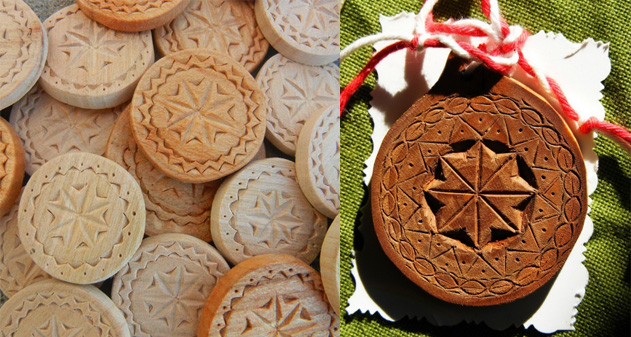
Mărţişoare de lemn/Wood tokens – 1 / 2
Cel mai frumos şi cel mai concis ne spune George Coşbuc, într-un studiu dedicat mărţişorului: „scopul purtării lui este să-ţi apropii soarele, purtându-i cu tine chipul. Printr-asta te faci prieten cu soarele, ţi-l faci binevoitor să-ţi dea ce-i stă în putere, mai întâi frumuseţe ca a lui, apoi veselie şi sănătate, cinste, iubire şi curăţie de suflet… Ţăranii pun copiilor mărţişoare ca să fie curaţi ca argintul şi să nu-i scuture frigurile, iar fetele zic că-l poartă ca să nu le ardă soarele şi cine nu le poartă are să se ofilească.”
Mărțișorul și 1 Martie o păstrează vie în povestea lor și pe Baba Dochia. Caracter mitologioc cu origini în cultul Mamei Natură, Baba Dochia este o divinitate agrară a spațiului Carpatin. Ca mai toate legendele păstrate prin narativ povestit în loc de scris există multe variante ale poveștii ei. O filieră a acestor povești spune cât de urât și-a tratat ea fica vitregă sau, alteori, nora. Fata care îi devine țintă într-o variantă a legendei este chiar dragostea fiului ei Dragobete, pe care acesta o luase de nevastă fără binecuvântarea ei. Pentru a își arată supărarea, Baba Dochia îi dă de făcut fetei lucruri menite a fi imposibile, precum să transforme lână neagră în lână albă sau să găsească fructe proaspete în pădure la sfârșitul iernii când zăpada era încă în strat gros. Fiind poveste de basm, tânăra primește mereu ajutor magic și revine acasă cu problema rezolvată. La finalul poveștii și în deschiderea primăverii, Baba Dochia își găsește sfârșitul plecând pe munte cu cele 12 cojoace ale ei și însoțită de oi. Forțată de împrejurimi Dochia leapădă cojoacele unul câte unul ajungând pe munte într-o iarnă grea încă în forță. Drept pedeapsă pentru răutățile ei este transformată în piatră pentru eternitate.
La origine firul de mărțișor era negru și alb, negru ca sufletul Babei și alb ca inima norei. Se zice că sângele vărsat de noră în timp ce spăla lâna neagră încercand a o albii este motivul pentru care firul este acum roșu și alb. Oricare ar fi varianta aleasă mărțișorul este un simbol al căldurii, al iubirii și al bunătății.
The general knowledge is that the 1st of March tradition is a celebration for the arrival of Spring. It’s most prominent element is a red and white wire gifted together with a token which symbolizes the summer and winter, the good and the bad, the day and the night. The token can be anything, though symbols like clover, horseshoe and chimney sweeper are more common, being said to bring good luck. The tokens are given by boys to girls and by girls to girls with small exceptions in few areas of the country where they are shared with everybody. The preferred tokens are worn pinned to the blouse sometimes even for 2 weeks. The wire is worn around the wrist for the entire month of March. Afterwards the wires are tied in a tree with flowers in bloom of personal choosing for one to be as beautiful as the Flowers of the tree for the year to come.
I personally believe that the most beautiful description of this tradition was given to us by the poet George Coşbuc in a study paper: „the purpose of wearing it is to befriend the sun by carrying his image. Through that one becomes his friend and makes him willing to give everything he can, first beauty as his own, then joyfulness and health, honesty and a purity of spirit. Peasants give mărțișor tokens to their children so that they are pure as the silver and to be protected from fever. The girls say that they are wearing it not to be burned by the sun but also that those who do not wear it will wither.”
The 1st of march token tradition also keeps alive the story of „Baba Dochia” – „The Old Lady Dochia”, who is a mythological and folkloric character with origins in the ancient cult of Mother Earth. Like most folklore stories there are many versions of her legend. Some of them tell us how mean she was to her step daughter or her daughter in law. The girl that becomes her target is sometimes the love of her son, Dragobete. Due to the fact that he marries her against her mother’s will and without her blessing she takes it upon herself to punish the unassuming girl. The tasks she assigns to the young girl are meant to be impossible to achieve. However as the story has a hint of fairy tale, the girl always receives almost magical help and gets to stay another day. The tasks include finding fresh fruits in the forest at the end of winter or even turning black wool into white wool. At the end of the story the Old Lady Dochia finds her end on the mountain together with her sheep. Forced by the weather she discards one by one the 12 winter coats that she took on and freezes to a stone for eternity.
At its origins the wire of the token was black and white. Black as the soul of the old lady and white as the heart of the daughter in law. Some say that the blood of the young girl from washing the wool in an attempt to whiten it is the reason behind the change to red an white combination of today. Whichever the version you choose the 1st of March token is a symbol of warmth, love and kindness.
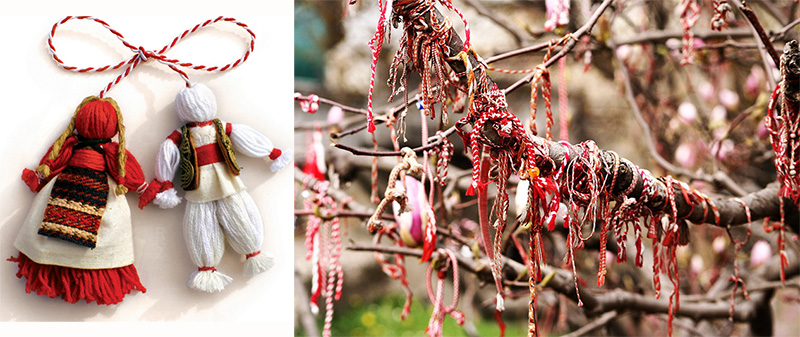
Marteniţa şi copaci cu fire de mărţişor / Martenisa and trees filled with the red and white wire – 1 / 2
Din studiile făcute pentru un workshop de prezentare al mărţişorului şi din discuţiile avute cu colegi şi prieteni greci şi bulgari am aflat că tradiţia mărţişorului în această formă este unică în lume. În Bulgaria mărţişorul este reprezentat de „marteniţă”. Marteniţa este reprezentarea unui băiat şi o fată, făcuţi folosind fir roşu pentru fată (Penda) şi fir alb pentru băiat (Pizho). Ca şi în cazul mărţişorului în România, rolul principal al marteniţei este de a aduce sănătate şi bunăstare şi de a deschide drumul primăverii şi căldurii în noul an.
Baba Marta este proeminentă în tradiţia bulgară aducând aminte de Baba Dochia şi rolul ei în deschiderea primăverii. Prin purtarea marteniţei se caută îndurarea Babei Marta şi o trecere de la iarnă la primăvară cât mai uşoară. Din păcate nu am prea multe detalii despre tradiţia mărţişorului în Grecia. Tradiţia pare a fi lipsită de importanţa dată în România şi Bulgaria sau poate doar uitată în marile oraşe şi păstrată doar în zonele rurale. Tradiţia pastrată este un simbol al primăverii iar firul de mărţişor se poartă la fel ca la noi la încheietura mâinii.
Este mai mult ca probabil ca tradiţia să se regăsească în forme mai mult sau mai puţin concentrate în mai multe zone din Balcani, însă această amploare culturală am regăsit-o, până acum, doar în România şi Bulgaria.
From research done for a workshop presentation and from conversations had with Bulgarian and Greek colleagues I learned that despite the presence of similar manifestations, the tradition in this form is unique in the world.
In Bulgaria the token is represented mainly by the „martenitsa” which is composed of two dolls made out of red and white wire. The girl Penda is typically made out of the red wire while the boy Pizho is made using the white wire. Similar to the 1st of March token in Romania the main purpose of the martenitsa is to bring health and prosperity and to pave the way for the arrival of the Spring. Baba Marta – The Old Lady March is a prominent character of the tradition. While it reminds of the Old Lady Dochia, her part is much bigger and more present in the Bulgarian tradition than the one of Dochia in Romania. People wear the martenisa in order to receive the mercy of the Old Lady Marta and have a easy transition from winter to spring.
Unfortunately I do not have many details in regard to the Greek tradition involving the 1st of March wire. So far it seems to be lacking the importance given in Romania and Bulgaria. It might just have been forgotten in the larger cities and preserved mostly in the smaller rural areas. What I do know is that the tradition is as in the other regions a symbol of spring and that the wire is also worm around the wrist during the month of March.The tradition is most likely kept in one version or another in many more areas of the Balkans, however I am not yet aware of other areas where it has the same intensity in manifestation as in Romania and Bulgaria.
De-a lungul anilor reacţiile străinilor la tradiţia mărţişorului au fost extrem de pozitive. Oamenii au simţit şi gustat cu adevărat simbolismul şi emoţia acesteia. În ultimul an de master am organizat în cadrul asociaţiei studenţeşti, împreună cu o colegă şi prietenă de origine din Bulgaria, un workshop de prezentare a tradiţiei. După poveştile de introducere le-am pus la dispoziţie materiale pentru a crea mărţişoare şi marteniţe. Cel mai emoţionant moment al workshop-ului a fost când am observat că participanţii nu păstrau mărţişoarele create ci le dăruiau celorlalţi participanţi. Atunci am realizat cât de puternic percepuseră esenţa mărţişorului de a dărui.
La început am dăruit mărţişoare doar românilor, dar în timp am început să împart şi cu colegii din alte ţări, prietenii olandezi dar şi de alte origini. Oamenii sunt deschişi şi apreciază enorm tradiţia din spate, emoţia şi povestea primăverii. Pentru că eu aleg să păstrez această tradiţie în jurul meu şi să creez an de an modele noi, prietenii care au fost expuşi câţiva ani la rând au început să anticipeze momentul şi chiar să creeze mărţişoare pentru a dărui la rîndul lor.
De fiecare dată când le-am împărțit, fetele și-au legat firele de mărțișor la încheietură în așteptarea copacului perfect iar pe băieți i-am îndulcit cu ciocolată. Chiar zilele trecute o prietenă finlandeză mi-a mărturisit că poartă cu ea, chiar și acum un an mai târziu, mărțișorul primit. Firul e de mult pierdut, dar sentimentul oferit încă păstrează căldură.
Throughout the years the reactions of the foreigners to the 1st of March tradition have been extremely positive. The people have really felt the symbolism and its emotion. In my last year of master studies together with a colleague and friend from Bulgaria and supported by the Student Association we organized a presentation workshop about the tradition. After the presentation participants were provided with the necessary materials to create their own tokens and martenisa’s. For me the emotional highlight of the evening was when I realized that the student were not keeping the newly created tokens and they were gifting them as they were making them, That is when I realized how strong they perceived the core essence of giving of this tradition.
At the beginning I was sharing the tradition only with other Romanian expats, however in time I started to share it with colleagues from other countries. People are open and appreciate the tradition behind the token, the emotion and the story. Because I choose to maintain the tradition and to create yearly new designs, the friends that were exposed for a while now have come to anticipate and expect the moment and in some cases even create themselves tokens to be gifted.
Every time I have shared them, the girls have wrapped the wires around their wrists starting the search for the perfect tree, while the boys got sweetened with chocolate in order not to feel left out. The other day a Finish friend confessed that she still carries with her the token received last year. The wire is long gone, however the token still carries the emotion.
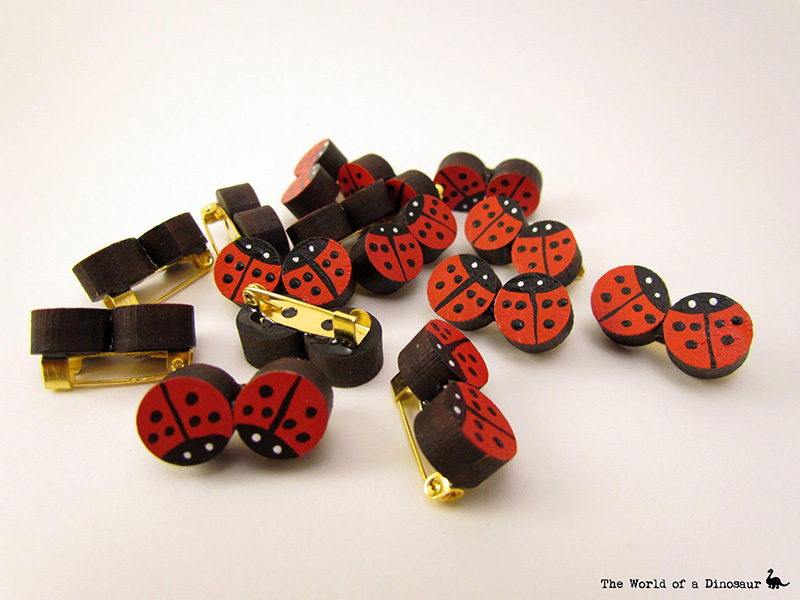
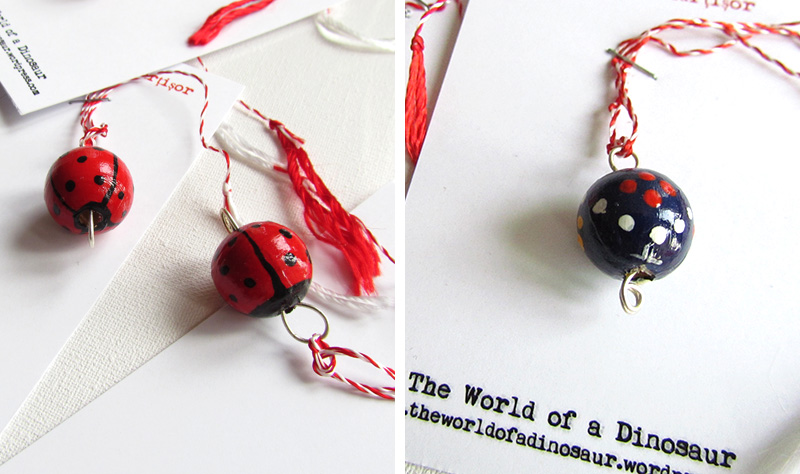
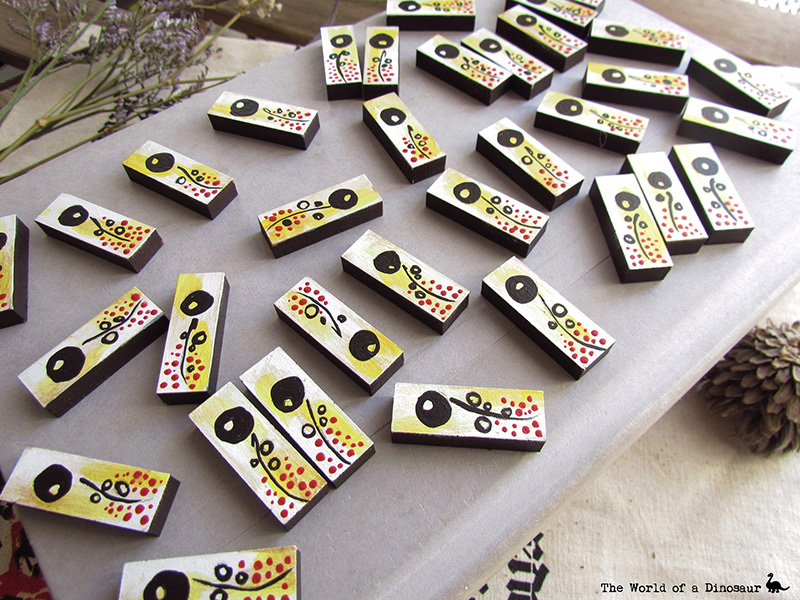
Cultura Europei de Vest pare rece la prima impresie şi multă lume scoate în evidenţă comercialismul acesteia pentru a o denigra. Din experienţa mea ca expat pe mai multe meleaguri am înţeles importanţa istoriei asupra evoluţiei unei culturi şi a impactului asupra emoţionalului unei societăţi. Oamenii sunt deschişi. Deschide-le uşa şi vor intra. Atu-ul neştiut al românului este emoţia. Emoţia de a fi deschis şi real. Dar aceasta emoţie a românului trebuie regăsită, păstrată şi cultivată.
Povestea mărţişorului are mai multe variante pe meleagurile mioritice. Eu personal o aleg pe cea descrisă de Coşbuc. Prefer să cred că românul cere sprijinul soarelui prin mărţişor şi astfel colaborează cu acesta. Această variantă îl pune pe român într-o lumină pozitivă arătând că îşi asumă responsabilitatea şi că îşi cunoaşte puterea, dar că înţelege rolul soarelui şi locul său ca om în contextul universului. Vă invit astfel să vă cunoaşteţi tradiţiile, să le cercetaţi şi să le aflaţi adevărata valoare. Vă invit să le împărţiţi apoi cu lumea din jurul vostru. Vă asigur că oamenii vă vor suprinde pozitiv şi veţi avea parte de momente frumoase. Nu insistaţi însă. Deschideţi uşa sufletului şi primăvara vă va găsi în timpul ei.
At first glance the culture of the Western Europe might seem cold, enhanced also by the fact that many people tend to emphasize its commercialism in order to denigrate it. My experience as an expat has helped me understand the importance of history in the evolution of a culture and of the impact over the emotional of a society. People are naturally open if allowed. The advantage of a Romanian is the emotion and the realness of it. However this is not a given and it does have to be found, kept and maintained.
The story of the 1st of March tradition and its token has many versions throughout Romania. Personally, I choose to believe the one described by Coşbuc. I choose to believe that we ask the support of the Sun and in doing so collaborating with him. This version portraits us in positive light showing responsibility and knowledge of oneself, while understanding the greatness of the Sun and our place in the context of the Universe. I thus invite you to get to know your traditions, to research them and to learn their true value. I then invite you to share them. It is best though not to insist. Allow people to open in their own time. I assure you that people will surprise in a positive way and beautiful moments will arise.

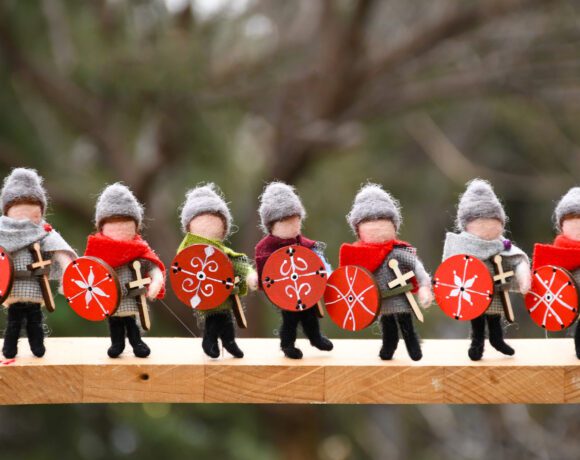
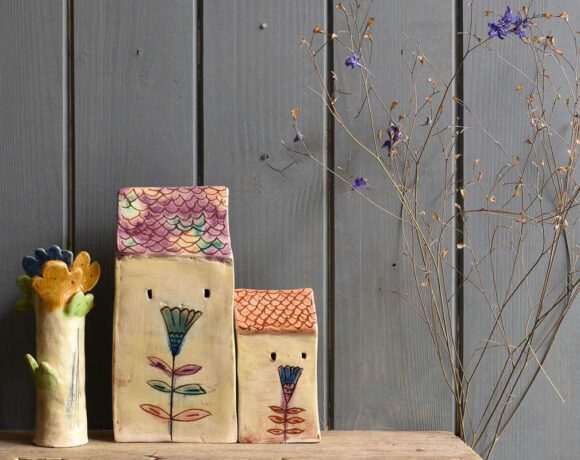
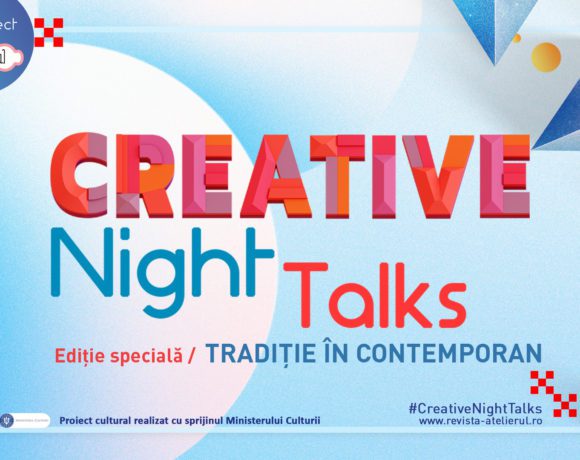
1st of March | THE WORLD OF A DINOSAUR
12 martie
[…] The paragraphs above are part of my latest article on Revista Atelierul. The article is written from the perspective of the expat and it is very close to my heart. You can find both the English and Romanian version here. […]